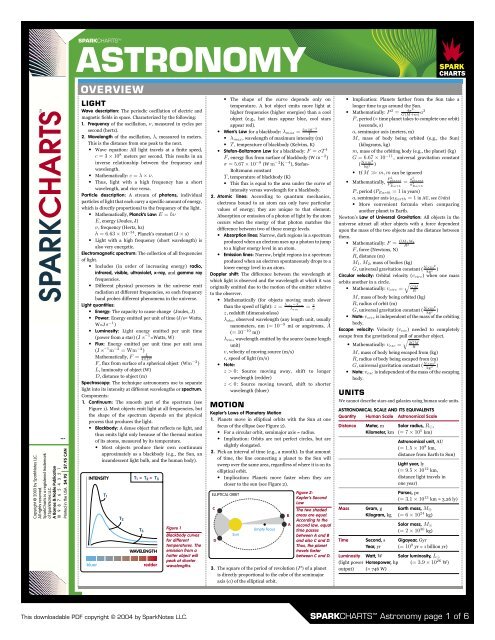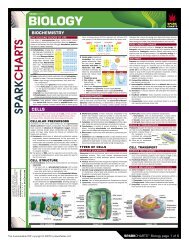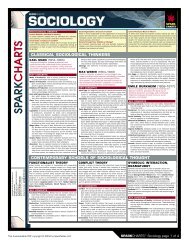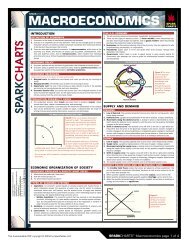Astronomy SparkChart - SparkNotes
Astronomy SparkChart - SparkNotes
Astronomy SparkChart - SparkNotes
You also want an ePaper? Increase the reach of your titles
YUMPU automatically turns print PDFs into web optimized ePapers that Google loves.
<strong>Astronomy</strong> 4.x.1 3/21/03 10:49 AM Page 1<br />
5 0 4 9 5<br />
ISBN 1-58663-637-5<br />
9 7 8 1 5 8 6 6 3 6 3 7 1<br />
Copyright © 2003 by <strong>SparkNotes</strong> LLC.<br />
All rights reserved.<br />
<strong>SparkChart</strong>s is a registered trademark<br />
of <strong>SparkNotes</strong> LLC.<br />
A Barnes & Noble Publication<br />
10 9 8 7 6 5 4 3 2 1<br />
Printed in the USA $4.95 $7.95 CAN<br />
SPARKCHARTSTM<br />
SPARKCHARTS TM<br />
ASTRONOMY SPARK<br />
OVERVIEW<br />
LIGHT<br />
Wave description: The periodic oscillation of electric and<br />
magnetic fields in space. Characterized by the following:<br />
1. Frequency of the oscillation, ν, measured in cycles per<br />
second (hertz).<br />
2. Wavelength of the oscillation, λ, measured in meters.<br />
This is the distance from one peak to the next.<br />
• Wave equation: All light travels at a finite speed,<br />
c = 3 × 10 8 meters per second. This results in an<br />
inverse relationship between the frequency and<br />
wavelength.<br />
• Mathematically: c = λ × ν.<br />
• Thus, light with a high frequency has a short<br />
wavelength, and vice versa.<br />
Particle description: A stream of photons, individual<br />
particles of light that each carry a specific amount of energy,<br />
which is directly proportional to the frequency of the light.<br />
• Mathematically, Planck’s Law: E = hν<br />
E, energy (Joules, J)<br />
ν, frequency (Hertz, hz)<br />
h = 6.63 × 10 −34 , Planck’s constant (J × s)<br />
• Light with a high frequency (short wavelength) is<br />
also very energetic.<br />
Electromagnetic spectrum: The collection of all frequencies<br />
of light.<br />
• Includes (in order of increasing energy) radio,<br />
infrared, visible, ultraviolet, x-ray, and gamma ray<br />
frequencies.<br />
• Different physical processes in the universe emit<br />
radiation at different frequencies, so each frequency<br />
band probes different phenomena in the universe.<br />
Light quantities:<br />
• Energy: The capacity to cause change (Joules, J)<br />
• Power: Energy emitted per unit of time (J/s= Watts,<br />
W=J s −1 )<br />
• Luminosity: Light energy emitted per unit time<br />
(power from a star) (J s −1 =Watts, W)<br />
• Flux: Energy emitted per unit time per unit area<br />
(J s −1 m −2 = Wm −2 )<br />
Mathematically, F = L<br />
4πD 2<br />
F , flux from surface of a spherical object (Wm −2 )<br />
L, luminosity of object (W)<br />
D, distance to object (m)<br />
Spectroscopy: The technique astronomers use to separate<br />
light into its intensity at different wavelengths or spectrum.<br />
Components:<br />
1. Continuum: The smooth part of the spectrum (see<br />
Figure 1). Most objects emit light at all frequencies, but<br />
the shape of the spectrum depends on the physical<br />
process that produces the light.<br />
• Blackbody: A dense object that reflects no light, and<br />
thus emits light only because of the thermal motion<br />
of its atoms, measured by its temperature.<br />
• Most objects produce their own continuum<br />
approximately as a blackbody (e.g., the Sun, an<br />
incandescent light bulb, and the human body).<br />
INTENSITY<br />
bluer<br />
T1<br />
This downloadable PDF copyright © 2004 by <strong>SparkNotes</strong> LLC.<br />
T2<br />
T1 > ><br />
T2 T3<br />
T3<br />
WAVELENGTH<br />
redder<br />
Figure 1<br />
Blackbody curves<br />
for different<br />
temperatures. The<br />
emission from a<br />
hotter object will<br />
peak at shorter<br />
wavelengths.<br />
• The shape of the curve depends only on<br />
temperature. A hot object emits more light at<br />
higher frequencies (higher energies) than a cool<br />
object (e.g., hot stars appear blue, cool stars<br />
appear red).<br />
• Wien’s Law for a blackbody: λmax = 3×10−3<br />
T<br />
• λmax, wavelength of maximum intensity (m)<br />
• T , temperature of blackbody (Kelvins, K)<br />
• Stefan-Boltzmann Law for a blackbody: F = σT 4<br />
F , energy flux from surface of blackbody (W m−2 )<br />
σ = 5.67 × 10−8 (W m−2K−4 ), Stefan-<br />
Boltzmann constant<br />
T , temperature of blackbody (K)<br />
• This flux is equal to the area under the curve of<br />
intensity versus wavelength for a blackbody.<br />
2. Atomic lines: According to quantum mechanics,<br />
electrons bound to an atom can only have particular<br />
values of energy; they are unique to that element.<br />
Absorption or emission of a photon of light by the atom<br />
occurs when the energy of that photon matches the<br />
difference between two of these energy levels.<br />
• Absorption lines: Narrow, dark regions in a spectrum<br />
produced when an electron uses up a photon to jump<br />
to a higher energy level in an atom.<br />
• Emission lines: Narrow, bright regions in a spectrum<br />
produced when an electron spontaneously drops to a<br />
lower energy level in an atom.<br />
Doppler shift: The difference between the wavelength at<br />
which light is observed and the wavelength at which it was<br />
originally emitted due to the motion of the emitter relative<br />
to the observer.<br />
• Mathematically (for objects moving much slower<br />
than the speed of light): z = λobs−λem v = λem c<br />
z, redshift (dimensionless)<br />
λobs, observed wavelength (any length unit, usually<br />
nanometers, nm (= 10−9 m) or angstroms, ˚A<br />
(= 10−10 m))<br />
λem, wavelength emitted by the source (same length<br />
unit)<br />
v, velocity of moving source (m/s)<br />
c, speed of light (m/s)<br />
• Note:<br />
z > 0: Source moving away, shift to longer<br />
wavelength (redder)<br />
z < 0: Source moving toward, shift to shorter<br />
wavelength (bluer)<br />
MOTION<br />
Kepler’s Laws of Planetary Motion<br />
1. Planets move in elliptical orbits with the Sun at one<br />
focus of the ellipse (see Figure 2).<br />
• For a circular orbit, semimajor axis = radius.<br />
• Implication: Orbits are not perfect circles, but are<br />
slightly elongated.<br />
2. Pick an interval of time (e.g., a month). In that amount<br />
of time, the line connecting a planet to the Sun will<br />
sweep over the same area, regardless of where it is on its<br />
elliptical orbit.<br />
• Implication: Planets move faster when they are<br />
closer to the sun (see Figure 2).<br />
ELLIPTICAL ORBIT<br />
C<br />
D<br />
Sun<br />
Empty focus<br />
3. The square of the period of revolution (P ) of a planet<br />
is directly proportional to the cube of the semimajor<br />
axis (a) of the elliptical orbit.<br />
B<br />
A<br />
Figure 2:<br />
Kepler’s Second<br />
Law<br />
The two shaded<br />
areas are equal.<br />
According to the<br />
second law, equal<br />
time passes<br />
between A and B<br />
and also C and D.<br />
Thus, the planet<br />
travels faster<br />
between C and D.<br />
CHARTS TM<br />
• Implication: Planets farther from the Sun take a<br />
longer time to go around the Sun.<br />
• Mathematically: P 2 = 4π2<br />
G(M+m) a3<br />
P , period (= time planet takes to complete one orbit)<br />
(seconds, s)<br />
a, semimajor axis (meters, m)<br />
M , mass of body being orbited (e.g., the Sun)<br />
(kilograms, kg)<br />
m, mass of the orbiting body (e.g., the planet) (kg)<br />
G = 6.67 × 10−11 , universal gravitation constant<br />
( N×m2<br />
kg2 )<br />
• If M >> m, m can be ignored<br />
2<br />
Pplanet • Mathematically,<br />
P 2<br />
Earth<br />
= a3<br />
planet<br />
a 3<br />
Earth<br />
P , period (PEarth = 1 in years)<br />
a, semimajor axis (aEarth = 1 in AU, see Units)<br />
• More convenient formula when comparing<br />
another planet to Earth.<br />
Newton’s Law of Universal Gravitation: All objects in the<br />
universe attract all other objects with a force dependent<br />
upon the mass of the two objects and the distance between<br />
them.<br />
• Mathematically: F = GM1M2<br />
R2 F , force (Newtons, N)<br />
R, distance (m)<br />
M1, M2, mass of bodies (kg)<br />
G, universal gravitation constant ( N×m2<br />
kg2 )<br />
Circular velocity: Orbital velocity (vcirc) when one mass<br />
orbits another in a circle. �<br />
GM<br />
• Mathematically: vcirc = R<br />
M , mass of body being orbited (kg)<br />
R, radius of orbit (m)<br />
G, universal gravitation constant ( N×m2<br />
2 )<br />
• Note: vcirc is independent of the mass of the orbiting<br />
body.<br />
Escape velocity: Velocity (vesc) needed to completely<br />
escape from the gravitational pull of another object.<br />
�<br />
2GM<br />
• Mathematically: vesc = R<br />
M , mass of body being escaped from (kg)<br />
R, radius of body being escaped from (m)<br />
G, universal gravitation constant ( N×m2<br />
kg2 )<br />
• Note: vesc is independent of the mass of the escaping<br />
body.<br />
UNITS<br />
We cannot describe stars and galaxies using human scale units.<br />
ASTRONOMICAL SCALE AND ITS EQUIVALENTS<br />
Quantity Human Scale Astronomical Scale<br />
Distance Meter, m Solar radius, R�,<br />
Kilometer, km (= 7 × 10 5 km)<br />
SPARKCHARTS <strong>Astronomy</strong> page 1 of 6<br />
kg<br />
Astronomical unit, AU<br />
(= 1.5 × 10 8 km,<br />
distance from Earth to Sun)<br />
Light year, ly<br />
(= 9.5 × 10 12 km,<br />
distance light travels in<br />
one year)<br />
Parsec, pc<br />
(= 3.1 × 10 13 km = 3.26 ly)<br />
Mass Gram, g Earth mass, M⊕<br />
Kilogram, kg (= 6 × 10 24 kg)<br />
Solar mass, M�<br />
(= 2 × 10 30 kg)<br />
Time Second, s Gigayear, Gyr<br />
Year, yr (= 10 9 yr = 1 billion yr)<br />
Luminosity Watt, W Solar luminosity, L�<br />
(light power Horsepower, hp (= 3.9 × 10 26 W)<br />
output) (= 746 W)<br />
“IT I<br />
COM<br />
THE<br />
THE<br />
EAR<br />
EART<br />
Compos<br />
thick lay<br />
• T<br />
s<br />
Motions<br />
• R<br />
e<br />
•<br />
•<br />
• R<br />
3<br />
Seasons<br />
• W<br />
w<br />
th<br />
s<br />
• A<br />
H<br />
s<br />
• N<br />
to<br />
c<br />
2<br />
S<br />
Winter<br />
Hemis<br />
Figure<br />
The til<br />
seaso<br />
Magnet<br />
charged<br />
• It<br />
(s<br />
re<br />
• M<br />
p<br />
fi<br />
1. V<br />
tr<br />
2. A<br />
th<br />
w<br />
s<br />
3. M<br />
fi<br />
4<br />
p<br />
in<br />
Solar W<br />
Figure<br />
THE M<br />
Compos<br />
possibly<br />
• High<br />
Moo
SPARK<br />
CHARTS TM<br />
ther from the Sun take a<br />
the Sun.<br />
4π 2<br />
(M+m) a3<br />
takes to complete one orbit)<br />
s, m)<br />
g orbited (e.g., the Sun)<br />
ody (e.g., the planet) (kg)<br />
versal gravitation constant<br />
e ignored<br />
= a3<br />
planet<br />
a3 Earth<br />
n years)<br />
h = 1 in AU, see Units)<br />
rmula when comparing<br />
th.<br />
vitation: All objects in the<br />
ts with a force dependent<br />
s and the distance between<br />
1M2<br />
R 2<br />
(kg)<br />
constant ( N×m2<br />
kg2 )<br />
ity (vcirc) when one mass<br />
�<br />
GM<br />
R<br />
rbited (kg)<br />
constant ( N×m2<br />
kg2 )<br />
t of the mass of the orbiting<br />
sc) needed to completely<br />
ll of another object.<br />
�<br />
2GM<br />
R<br />
scaped from (kg)<br />
scaped from (m)<br />
constant ( N×m2<br />
kg2 )<br />
t of the mass of the escaping<br />
xies using human scale units.<br />
EQUIVALENTS<br />
tronomical Scale<br />
lar radius, R�,<br />
7 × 10 5 km)<br />
tronomical unit, AU<br />
1.5 × 10 8 km,<br />
tance from Earth to Sun)<br />
ht year, ly<br />
9.5 × 10 12 km,<br />
tance light travels in<br />
e year)<br />
rsec, pc<br />
3.1 × 10 13 km = 3.26 ly)<br />
rth mass, M⊕<br />
6 × 10 24 kg)<br />
lar mass, M�<br />
2 × 10 30 kg)<br />
ayear, Gyr<br />
10 9 yr = 1 billion yr)<br />
lar luminosity, L�<br />
(= 3.9 × 10 26 W)<br />
“IT IS CLEAR TO EVERYONE THAT ASTRONOMY AT ALL EVENTS<br />
COMPELS THE SOUL TO LOOK UPWARDS, AND DRAWS IT FROM<br />
THE THINGS OF THIS WORLD TO THE OTHER.” PLATO<br />
THE SOLAR SYSTEM<br />
EARTH-MOON-SUN SYSTEM<br />
EARTH<br />
Composition: Three layers; a solid iron and nickel core, a<br />
thick layer of mantle, and a thin outer crust.<br />
• The shape of Earth is an oblate spheroid (a slightly<br />
squished sphere).<br />
Motions<br />
• Rotation: Movement of Earth around its axis once<br />
every 24 hours.<br />
• At any given time, the Sun lights up half of Earth.<br />
• Day and night begin as a spot on Earth moves into<br />
or out of the illuminated half.<br />
• Revolution: Earth travels around the Sun once every<br />
365.25 days (one year).<br />
Seasons: Caused by the fixed tilt of Earth’s axis (see Figure 3).<br />
• When the North Pole points away from the Sun, it is<br />
winter in the Northern Hemisphere. This is because<br />
the rays of the Sun are tilted and do not warm the<br />
surface efficiently.<br />
• At the same time, it is summer in the Southern<br />
Hemisphere. This is because the rays of the Sun<br />
strike the surface from almost directly overhead.<br />
• Note: The slight variation in the distance from Earth<br />
to the Sun, which is caused by Earth’s slightly noncircular<br />
orbit, is irrelevant to the changes in seasons.<br />
23.5°<br />
23.5°<br />
N N<br />
S<br />
Winter in Southern<br />
Hemisphere<br />
Figure 3<br />
The tilt of the Earth’s rotation axis is the cause for the<br />
seasons. This diagram is not drawn to scale.<br />
Magnetic field: Generated by the rotational motions of<br />
charged particles in the liquid part of the core.<br />
• It emerges from Earth at the North Magnetic Pole<br />
(slightly offset from Earth’s rotation axis), and<br />
returns to the South Magnetic Pole (see Figure 4).<br />
• Magnetic fields interact with moving charged<br />
particles and cause them to spiral around magnetic<br />
field lines. This leads to 3 important phenomena:<br />
1. Van Allen Belts: Charged particles from space get<br />
trapped in the magnetic field lines of Earth.<br />
2. Aurorae (Northern and Southern lights): Caused by<br />
the deexcitation of atoms and molecules that occurs<br />
when charged particles trapped by the magnetic field<br />
strike the Earth’s atmosphere near the poles.<br />
3. Magnetosphere: Extension of the Earth’s magnetic<br />
field hundreds of Earth radii into space (see Figure<br />
4). It traps or deflects the constant flow of charged<br />
particles from the Sun. The Van Allen Belts are the<br />
inner parts of the magnetosphere.<br />
Solar Wind<br />
Van Allen Belts<br />
S<br />
Winter in Northern<br />
Hemisphere<br />
Magnetosphere field lines<br />
Figure 4: Earth’s magnetic field and magnetosphere<br />
THE MOON<br />
Composition: Low-density crust, a silica-rich mantle, and<br />
possibly metallic (iron) core.<br />
• Highlands: The highly cratered and brighter parts of<br />
Moon’s surface.<br />
This downloadable PDF copyright © 2004 by <strong>SparkNotes</strong> LLC.<br />
• Maria (from the Latin for “sea”): The smoother and<br />
darker lowlands on the Moon’s surface.<br />
• Because maria are less cratered, they are thought to<br />
have formed later, possibly by volcanic activity.<br />
Phases: Caused by the relative alignment of Earth, the<br />
Moon, and the Sun.<br />
• One half of the Moon is always illuminated by the Sun.<br />
• The portion of the illuminated half that we see<br />
determines the shape of that particular phase.<br />
• Cycle of phases repeats every 29 1<br />
2 days (see Figure 5).<br />
D<br />
A<br />
New<br />
Moon<br />
C<br />
E<br />
B<br />
Waxing<br />
crescent<br />
Moon<br />
LIGHT FROM SUN<br />
Figure 5: The phases of the moon. Diagram not to scale.<br />
Eclipses (see Figure 6)<br />
• Solar: The Moon moves between the Sun and Earth,<br />
and casts its shadow on Earth. A total solar eclipse<br />
(the Moon completely covers the Sun) can occur even<br />
though the Sun’s radius is 375 times the Moon’s<br />
radius because the Earth-Moon distance is much less<br />
than the Earth-Sun distance.<br />
• Lunar: The Moon moves directly behind the line<br />
between the Sun and Earth, and Earth casts its<br />
shadow on the Moon.<br />
SOLAR ECLIPSE<br />
C<br />
First<br />
quarter<br />
Moon<br />
B<br />
D<br />
Waxing<br />
gibbous<br />
Moon<br />
F<br />
VIEWS OF THE MOON AS SEEN FROM EARTH<br />
E<br />
Full<br />
Moon<br />
F<br />
Waning<br />
gibbous<br />
Moon<br />
G<br />
Last<br />
quarter<br />
Moon<br />
H<br />
Waning<br />
crescent<br />
Moon<br />
Earth Moon Sun<br />
Earth Moon<br />
Umbra<br />
• Eclipses do not occur once a month because the plane<br />
in which the Moon orbits is tilted about 5 degrees<br />
from the plane of Earth’s orbit around the Sun.<br />
Tides occur on Earth as a result of the gravitational pull of<br />
the Sun and the Moon.<br />
• The gravitational pull of any object gets weaker the<br />
further you move from the object. Thus, the Moon<br />
pulls harder on the water on the side of Earth nearer<br />
to it than on the water on the side of Earth farther<br />
from it. This creates a bulge in the water on the side<br />
of the Earth facing the Moon and another on the<br />
opposite side (see Figure 7). The Earth itself is more<br />
rigid, so essentially no bulge is created in its crust.<br />
A<br />
G<br />
H<br />
LUNAR ECLIPSE<br />
Penumbra<br />
Figure 6: Lunar and solar eclipses. Diagram not to scale.<br />
Figure 7: Spring and neap<br />
tides. Diagram not to scale.<br />
SPRING TIDE<br />
Oceans<br />
Earth<br />
NEAP TIDE<br />
Moon Sun<br />
High tide<br />
Low tide<br />
• A place on the Earth’s surface experiences high tide<br />
when that place faces toward (or away from) the<br />
Moon. Low tide occurs when the Earth has rotated<br />
90 degrees from high tide.<br />
• During a span of approximately 24 hours, every<br />
location on Earth passes through 2 high tides and 2<br />
low tides.<br />
• Spring tides (unrelated to the season): Strongest<br />
tides; occur when the tidal bulges created by the Sun<br />
and Moon line up.<br />
• Neap tides: Weakest tides; occur when the tidal<br />
bulges created by the Sun and Moon are at right<br />
angles to each other (see Figure 7).<br />
Impact theory of origin: A Mars-sized object struck Earth<br />
off-center, ejecting material that then formed the Moon.<br />
This theory is currently favored by geological evidence and<br />
computer simulations.<br />
PLANETS<br />
GENERAL TRENDS OF PLANETARY<br />
SCIENCE<br />
Active lifetime: The size of a planet determines its active<br />
lifetime.<br />
• The internal heat of a planet comes from<br />
gravitational contraction during the planet’s<br />
formation.<br />
• As the internal heat is radiated away into space,<br />
changes occur in both the internal structure and<br />
surface features of a planet.<br />
• When the heat is gone, the planet can no longer<br />
evolve from the inside, and it is considered dead.<br />
Atmosphere: The balance between the force of gravity on a<br />
planet and its average surface temperature determines the<br />
amount and composition of its atmosphere.<br />
• If the average velocity of gas molecules (determined<br />
by surface temperature) is greater than the escape<br />
speed of the planet (determined from its mass and<br />
size, see Orbits), then that molecule will not be<br />
present in the planet’s atmosphere.<br />
• Lighter molecules like hydrogen and helium are<br />
harder for a planet to hold onto because they move<br />
faster than heavy molecules at a given temperature.<br />
Internal structure:<br />
• Differentiation: If the internal heat is high enough,<br />
the materials that make up a planet will melt and the<br />
heavier components will sink to the center.<br />
• Average density: Total mass of a planet divided by<br />
its total volume.<br />
• High average density implies a mostly rocky planet.<br />
• Low average density implies a mostly gaseous planet.<br />
Surface features: Four main processes mold the surface of<br />
a planet:<br />
1. Cratering: Pits in the crust of planets form because of<br />
impacts with other solar system bodies.<br />
2. Erosion: Water flows and wind (if an atmosphere is<br />
present) wear away a planet’s surface features.<br />
3. Volcanism: Hot rock and other material rise to the<br />
surface of a planet.<br />
4. Plate tectonics: A layer of crust is broken into plates and<br />
rides on a lower layer of softened rock that is heated by<br />
natural radioactivity.<br />
• This theory explains earthquakes and volcanos by<br />
inferring that they are the result of plates being<br />
pushed together or driven apart.<br />
• Plate tectonics occurs only on Earth.<br />
TERRESTRIAL PLANETS<br />
Mercury, Venus, Earth (and its moon), and Mars.<br />
1. Atmosphere<br />
• Earth and Venus: Bigger planets can hold onto heavy<br />
molecules (such as nitrogen, carbon dioxide, and<br />
oxygen), but not hydrogen because the planets’<br />
surface temperatures are too high.<br />
SPARKCHARTS <strong>Astronomy</strong> page 2 of 6<br />
ASTRON<br />
THE S<br />
•<br />
• Mo<br />
bec<br />
• Ma<br />
COMPARI<br />
Planet<br />
Mercury<br />
Venus<br />
Earth<br />
Mars<br />
Moon<br />
2. Interna<br />
differe<br />
densiti<br />
3. Surfac<br />
• Ear<br />
vol<br />
con<br />
awa<br />
• Mo<br />
atm<br />
hap<br />
act<br />
• Ma<br />
like<br />
act<br />
JOVIAN<br />
Jupiter, S<br />
similaritie<br />
largest of<br />
1. Atmos<br />
• Jov<br />
and<br />
• The<br />
rot<br />
• The<br />
dee<br />
•<br />
•<br />
COMPARIS<br />
Planet<br />
Jupiter<br />
Saturn<br />
Uranus<br />
Neptune<br />
Pluto<br />
Me<br />
PICTURES<br />
2. Interna<br />
constu
EVENTS<br />
IT FROM<br />
PLATO<br />
’s surface experiences high tide<br />
es toward (or away from) the<br />
rs when the Earth has rotated<br />
tide.<br />
pproximately 24 hours, every<br />
sses through 2 high tides and 2<br />
ted to the season): Strongest<br />
tidal bulges created by the Sun<br />
st tides; occur when the tidal<br />
e Sun and Moon are at right<br />
(see Figure 7).<br />
Mars-sized object struck Earth<br />
l that then formed the Moon.<br />
ored by geological evidence and<br />
OF PLANETARY<br />
a planet determines its active<br />
of a planet comes from<br />
action during the planet’s<br />
t is radiated away into space,<br />
th the internal structure and<br />
planet.<br />
one, the planet can no longer<br />
e, and it is considered dead.<br />
etween the force of gravity on a<br />
ce temperature determines the<br />
its atmosphere.<br />
y of gas molecules (determined<br />
ure) is greater than the escape<br />
(determined from its mass and<br />
en that molecule will not be<br />
’s atmosphere.<br />
ike hydrogen and helium are<br />
o hold onto because they move<br />
lecules at a given temperature.<br />
e internal heat is high enough,<br />
ke up a planet will melt and the<br />
will sink to the center.<br />
tal mass of a planet divided by<br />
ity implies a mostly rocky planet.<br />
y implies a mostly gaseous planet.<br />
n processes mold the surface of<br />
rust of planets form because of<br />
system bodies.<br />
nd wind (if an atmosphere is<br />
anet’s surface features.<br />
nd other material rise to the<br />
f crust is broken into plates and<br />
softened rock that is heated by<br />
earthquakes and volcanos by<br />
are the result of plates being<br />
riven apart.<br />
s only on Earth.<br />
NETS<br />
its moon), and Mars.<br />
ger planets can hold onto heavy<br />
nitrogen, carbon dioxide, and<br />
ydrogen because the planets’<br />
are too high.<br />
ASTRONOMY<br />
THE SOLAR SYSTEM (CONTINUED)<br />
Mercury Venus Earth Mars<br />
PICTURES NOT TO SCALE<br />
• Greenhouse effect: Radiation incident on the<br />
surface of Venus is re-radiated at longer<br />
wavelengths that cannot get back out through<br />
the atmosphere. This trapped radiation heats<br />
the surface to very high temperatures. The same<br />
thing happens inside a closed car on a hot day.<br />
• Moon and Mercury: Have almost no atmosphere<br />
because of their low surface gravity.<br />
• Mars: Has a thin atmosphere of carbon dioxide.<br />
COMPARISON OF THE TERRESTRIAL PLANETS<br />
Planet Diameter Mass Density Surface Pressure<br />
Earth = 1 Earth = 1 Water = 1 Earth = 1<br />
Mercury 0.38 0.055 5.4 10 -15<br />
Venus 0.95 0.82 5.2 100<br />
Earth 1.0 1.0 5.5 1.0<br />
Mars 0.53 0.11 3.9 0.01<br />
Moon 0.27 0.012 3.3 10 -15<br />
2. Internal structure: All terrestrial planets have undergone<br />
differentiation (see Internal structure). They have high<br />
densities because of their rocky interiors.<br />
3. Surface features<br />
• Earth and Venus: The most active planets. Erosion,<br />
volcanic activity, and plate tectonics (on Earth)<br />
constantly renew their surfaces, rapidly wiping<br />
away evidence of cratering.<br />
• Moon and Mercury: Because they lack an<br />
atmosphere, they retain their craters. Cratering<br />
happened long ago, showing that no other surface<br />
activity has taken place for a long time.<br />
• Mars: Has huge dormant volcanoes and riverbedlike<br />
features that imply there was some volcanic<br />
activity and liquid water flow in its recent past.<br />
JOVIAN PLANETS<br />
Jupiter, Saturn, Uranus, and Neptune. Because of their<br />
similarities in composition, they are named after the<br />
largest of the group, Jupiter.<br />
1. Atmosphere<br />
• Jovian planets are made of gas in their outer layers<br />
and have no solid surface.<br />
• They exhibit differential rotation (gas at the equator<br />
rotates faster than gas at the poles).<br />
• Their hot interiors drive hot, dense material from<br />
deep in the atmosphere up to the cloud tops.<br />
• This results in a banded structure, which we can<br />
see most clearly in Jupiter and Saturn, and less<br />
so in Uranus and Neptune.<br />
• Small amounts of methane in the atmospheres<br />
of Uranus and Neptune give them a greenish<br />
and bluish color, respectively.<br />
COMPARISON OF THE JOVIAN PLANETS<br />
Planet Diameter Mass Bulk Density<br />
Earth = 1 Earth = 1 Water = 1<br />
Jupiter 11.0 318 1.3<br />
Saturn 9.5 95 0.7<br />
Uranus 4.1 15 1.2<br />
Neptune 3.9 17 1.7<br />
Pluto 0.17 0.002 2.1<br />
2. Internal structure: Two characteristics allow us to<br />
constuct models of Jovian planets:<br />
This downloadable PDF copyright © 2004 by <strong>SparkNotes</strong> LLC.<br />
a. Their sunlike density.<br />
b. Their ability to radiate more energy into space than<br />
they absorb from the Sun.<br />
• The models show that Jovian planets are active,<br />
differentiated worlds composed of:<br />
• A molecular hydrogen atmosphere<br />
• A liquid hydrogen (and metallic hydrogen in<br />
Jupiter and Saturn) interior<br />
• A (possibly) rocky core<br />
3. Surface features:<br />
• Jovian worlds do not have a solid surface, so<br />
evidence of cratering, erosion, and volcanism are<br />
not present.<br />
• Despite this, there are some stable surface features,<br />
including the Great Red Spot of Jupiter and the<br />
Great Dark Spot of Neptune, atmospheric storms of<br />
tremendous intensity that will last for many years.<br />
4. Moons: All Jovian planets have a large system of moons.<br />
• Tidal locking: Tidal forces have acted over time so<br />
that the same half of a moon points toward the parent<br />
planet at all times (as seen with Earth’s moon).<br />
5. Rings: All Jovian planets have rings.<br />
• Composition: Made up of many individual particles<br />
averaging one meter in size, all orbiting their parent<br />
planet according to Kepler’s Laws (see Orbits) in a disk<br />
about a kilometer thick. There are two types of particles:<br />
a. Icy: Seen as bright rings; found around Saturn.<br />
b. Rocky: Seen as dark rings; found around<br />
Jupiter, Neptune, Uranus.<br />
• Shepherd moons: A pair of small moons, one<br />
interior to the ring and one exterior to the ring<br />
which help to maintain the stability of the ring. The<br />
gravitational tugs of the shepherd moons act to<br />
herd the ring particles into the same orbit.<br />
• Pluto: The outermost planet and its moon, Charon, do<br />
not fit either of the above categories. Instead, they can<br />
be thought of as the largest icy bodies in the Kuiper Belt<br />
(see Comets).<br />
EXTRA-SOLAR PLANETS<br />
• “Hot Jupiter”: One of dozens of planets, with masses<br />
close to that of Jupiter, found orbiting very close to<br />
another star.<br />
• Migration: The current theory states that hot Jupiters<br />
formed further from their star and then migrated<br />
inward by some uncertain mechanism.<br />
Detection techniques:<br />
1. Doppler shift: A massive orbiting planet causes the<br />
position of its parent star to wobble. We can determine<br />
some orbital properties of the planet by watching the<br />
spectrum of the star shift back and forth because of<br />
this wobble.<br />
2. Transits: If a planet passes in front of its parent star, we<br />
see a dip in the intensity of the light from that star.<br />
From the shape of this dip, we can determine some<br />
properties of the planet, including its orbital period<br />
and size relative to its parent star.<br />
EXTRAS OF THE SOLAR<br />
SYSTEM<br />
COMETS<br />
Composition: Comets consist of four parts:<br />
a. Nucleus: A dirty snowball a few kilometers wide consisting<br />
of water and other organic ices mixed with dust.<br />
b. Coma: Region of gas and dust thrown off from the nucleus,<br />
measuring up to a million kilometers in diameter.<br />
Jupiter Saturn Uranus Neptune<br />
Uranus photo courtesy of NSSDC. Venus © DigitalVision<br />
Mercury, Earth, Mars, Jupiter, Saturn, and Neptune © PhotoDisc, Inc.<br />
c. Gas tail: Ions blown off the nucleus by the solar wind<br />
(see Solar Activity).<br />
d. Dust tail: Particles released from the melting ice that curve<br />
behind the gas tail; up to 150 million kilometers long.<br />
• Note: Tails are only present when a comet is close<br />
to the Sun.<br />
Origin:<br />
1. Kuiper belt: A collection of comet nuclei that orbit just<br />
beyond the orbit of Neptune.<br />
• Most comets with orbits of less than 200 years<br />
originate here.<br />
2. Oort Cloud: A collection of comet nuclei in a shell<br />
about 1,000 times as far out as Pluto’s orbit.<br />
• Most comets with orbits of longer than 200 years<br />
originate here.<br />
METEORITES<br />
• Chunks of matter up to tens of meters across, left<br />
behind by passing comets, may burn up as they pass<br />
into Earth’s atmosphere. They have different names<br />
depending on where they are relative to the<br />
atmosphere:<br />
1. Meteoroid: A chunk outside the atmosphere.<br />
2. Meteor (shooting star): The flash of light a chunk<br />
makes as it burns up in the atmosphere.<br />
3. Meteorite: A chunk that makes it to the ground.<br />
• Composition: There are types of meteorite: iron, stony,<br />
and stony-iron.<br />
ASTEROIDS<br />
• Minor planets that orbit mostly in a gap between the<br />
orbits of Mars and Jupiter.<br />
• Kirkwood gaps: Empty orbits in the asteroid belt with<br />
an orbital period of exactly 1 1<br />
2 or 3 that of Jupiter. They<br />
are empty due to orbital resonance.<br />
• Orbital resonance: The repeated tugging between<br />
two bodies on orbits with whole number orbital<br />
period ratios.<br />
• An asteroid and Jupiter both orbit the Sun, with<br />
the asteroid orbiting faster (from Kepler’s Third<br />
Law, see Kepler’s Laws)<br />
• Because of their period ratios, they are always closest<br />
to each other at the same point on their orbits.<br />
• The repeated gravitational tug the asteroid feels<br />
from Jupiter acts to tug it out of that orbit into one<br />
that does not have a perfect orbital period ratio.<br />
• This phenomenon also occurs for moons and<br />
rings orbiting a planet.<br />
FORMATION OF THE SOLAR<br />
SYSTEM<br />
Any formation scenario must explain the following<br />
evidence:<br />
• All planets orbit the Sun in nearly the same plane,<br />
in nearly circular orbits.<br />
• All planets travel around the sun in the same direction,<br />
which is also the direction of the Sun’s rotation.<br />
• Smaller, rocky planets orbit near the Sun, while larger,<br />
gaseous planets orbit further away from the Sun.<br />
• In the last ten years, we have found many nearby stars<br />
with planetary systems. Therefore, planet formation<br />
must be almost as common as star formation.<br />
Nebular theory: The most widely accepted theory of solar<br />
system formation (see Figure 8).<br />
a. About 5 billion years ago, a cloud of interstellar dust<br />
began to collapse. The trigger for this collapse is still<br />
unclear.<br />
CONTINUED ON OTHER SIDE<br />
SPARKCHARTS <strong>Astronomy</strong> page 3 of 6
E<br />
r<br />
<strong>Astronomy</strong> 4.x.1 3/21/03 10:49 AM Page 2<br />
THE SOLAR SYSTEM (CONTINUED)<br />
b. As the cloud of dust continued to collapse under its<br />
own gravity, the rotational speed of the particles<br />
increased because of conservation of angular<br />
momentum—the reason why an ice skater spins<br />
faster when his or her arms are pulled in—and the<br />
cloud became a flattened disk.<br />
c. Energy from the gravitational collapse caused the<br />
temperature in the center of the disk to rise until<br />
fusion started in the protosun. Micrometer-sized bits<br />
of dust began to stick together, and after about<br />
10,000 years, they reached a size of tens of kilometers<br />
across and were called planetesimals.<br />
d. Over tens of millions of years, the planetesimals collided<br />
and combined due to gravity, eventually forming planets.<br />
STELLAR ASTRONOMY<br />
OUR SUN<br />
STRUCTURE<br />
Solar interior<br />
• Core: Inner 10% of the Sun’s radius. The nuclear<br />
fusion that powers the Sun takes place in the core<br />
at a temperature of 15 million Kelvins.<br />
• Radiative zone: Layer of the Sun directly above<br />
the core. Energy is transported outward by<br />
radiation (the movement of photons).<br />
• Convective zone: Layer of the Sun above the<br />
radiative zone. Energy is transported outward by<br />
convection (hot gas rises and cooler gas falls).<br />
Solar atmosphere<br />
• Photosphere: Layer of the Sun we can see (the<br />
Sun’s surface).<br />
Temperature: 5800 K<br />
Composition: 74% hydrogen, 25% helium, and 1%<br />
all other elements (same as the rest of the sun).<br />
Granulation: Lighter and darker regions about<br />
1,000 km across, which cover the photosphere<br />
with a pattern that changes on average every 10<br />
minutes. They are created by convection that<br />
brings hot material to the Sun’s surface and<br />
pulls cooler material below the surface.<br />
• Chromosphere: Layer of the Sun above the<br />
photosphere that shows a pinkish glow during a<br />
total solar eclipse.<br />
Temperature: Rises from 4,200 K to 1 million K;<br />
due to radiation from photosphere as well as<br />
from magnetic fields extending up from the<br />
photosphere into the chromosphere.<br />
Thickness: 2,000 km<br />
• Corona: Layer above the chromosphere that is<br />
only visible during a total solar eclipse.<br />
Temperature: Approximately 2 million K;<br />
mechanism which generates this intense heat<br />
is unclear, but is related to magnetic activity.<br />
Composition: Small number of highly ionized<br />
atoms (low density) moving at high speeds<br />
(high temperature).<br />
Thickness: Extends from the top of the chromosphere<br />
out into the rest of the solar system.<br />
MAGNETIC FIELD<br />
Magnetic dynamo model: Description of how the Sun’s<br />
magnetic field changes over time. Two motions bring this<br />
about:<br />
1. Differential rotation: Gas at the equator (25-day period)<br />
rotates faster than gas at the poles (31-day period).<br />
• The Sun’s magnetic field lines are locked into the<br />
material just beneath the photosphere. Thus,<br />
when material at the surface near the equator gets<br />
pulled around more quickly than the material near<br />
the poles, the magnetic field lines get wound<br />
around the Sun (see Figure 9).<br />
2. Convection at the Sun’s surface: Hot material below<br />
the photosphere rises to the surface, as in granulation<br />
(see Photosphere).<br />
• Magnetic field lines locked into this material are<br />
thus brought up to the surface of the Sun. If the<br />
lines are wound tightly enough by differential<br />
rotation, they will kink and pop out of the<br />
photosphere, causing small regions of magnetic<br />
field that are thousands of times stronger than the<br />
Sun’s average magnetic field (see Figure 9).<br />
This downloadable PDF copyright © 2004 by <strong>SparkNotes</strong> LLC.<br />
• The planetesimals that did not form planets are<br />
thought to be the comets and asteroids in the solar<br />
system today.<br />
• Rocky planets formed near the Sun because the<br />
heat vaporized most icy components. Most<br />
gaseous components escape these planets because<br />
the surface temperature is too high and the force<br />
of gravity is too low (see Atmosphere, under Trends<br />
of Planetary Science).<br />
• Gas giant planets formed far from the Sun because<br />
the cooler gas could not escape their larger<br />
gravitational pull.<br />
Figure 9: Magnetic dynamo model<br />
SOLAR ACTIVITY<br />
• Most solar activity is thought to be related to the<br />
magnetic field of the Sun.<br />
• Sunspots: Temporary areas of cooler and darker gas<br />
that appear in groups on the photosphere.<br />
• Temperature: 4,200 K (less than 5,800 K average<br />
photosphere temperature).<br />
• Cause: Regions of strong magnetic field restrain<br />
the convective motion that brings hotter gas to the<br />
surface. Thus, sunspots are cooler.<br />
• Sunspot cycle: 11-year cycle, beginning with just a<br />
few sunspots near the poles that are replaced by more<br />
sunspots near the equator as the cycle continues.<br />
• Solar flares: Violent solar storms associated with<br />
regions of sunspots (and thus strong magnetic fields).<br />
• Temperature: Around 5 million K<br />
• Duration: About 20 minutes<br />
• Effect on Earth: Light reaches Earth in minutes,<br />
but energetic charged particles from the flare<br />
arrive on Earth days later. If the particles<br />
penetrate Earth’s magnetosphere, they may<br />
disrupt radio communication or disable satellites<br />
orbiting Earth (see Magnetic Field under Earth).<br />
• Solar prominences: Loops of gas that can rise tens of<br />
thousands of kilometers above the surface of the Sun.<br />
• Temperature: Around 10,000 K (this is how they<br />
are distinguished from solar flares).<br />
• Solar wind: Extension of the charged particles of the<br />
corona out into the solar system.<br />
• Temperature: Around 2 million K.<br />
STARS AS SUNS<br />
WHAT ARE THEY?<br />
• Star: Enormous, self-sustaining nuclear reactor made<br />
of mostly hydrogen gas; only known structures in the<br />
universe capable of taking the simple atoms present at<br />
the beginning of the universe and fusing them into the<br />
heavier elements needed for life.<br />
• Hydrostatic Equilibrium: A balance in the battle of<br />
gravity versus pressure at every point inside a star; a star<br />
will not expand, contract, or shift its internal structure.<br />
• Pressure: Outward force resulting from processes<br />
of energy generation (usually heat from fusion) or<br />
quantum mechanical effects (called degeneracy,<br />
see White Dwarfs).<br />
• Gravity: Inward force that attracts each bit of gas<br />
toward the center of the star.<br />
• Note: Major changes in the star during its lifetime<br />
occur when one of these forces temporarily wins<br />
out over the other, but the star always settles to a<br />
new state of equilibrium.<br />
A B<br />
Protosun<br />
Planetesimals<br />
Planets<br />
HOW DO THEY WORK?<br />
• Fusion: The combination of lighter atomic nuclei into<br />
heavier atomic nuclei. Fusion can only take place at<br />
very high temperatures (i.e., fast moving particles)<br />
and high pressures (i.e., tightly packed particles)<br />
because electrostatic repulsion between two positive<br />
nuclei must be overcome before the strong nuclear<br />
force causes the nuclei to combine.<br />
• Hydrogen fusion: There are two processes:<br />
1. Proton-proton (PP) chain: Four hydrogen nuclei fuse<br />
into one alpha particle and release high energy<br />
photons and neutrinos.<br />
• Alpha particle = helium nucleus<br />
• Requires chain of 3 separate nuclear reactions to<br />
go from initial reactants to final products.<br />
• Photons take about a million years to reach the<br />
surface of the star.<br />
• Occurs mostly in low mass stars (1.5 M� or less).<br />
2. Carbon-nitrogen-oxygen (CNO) cycle: Net reaction is<br />
the same as the PP chain: four hydrogen nuclei create<br />
one alpha particle.<br />
• Intermediate reaction steps involve isotopes of<br />
carbon, nitrogen, and oxygen as catalysts (they<br />
participate in reactions, but do not get used up).<br />
• More efficient than PP chain = higher yield of<br />
energy for same products.<br />
• Occurs mostly in higher mass stars (greater than<br />
1.5 M�).<br />
• Helium fusion (Triple alpha process): Three alpha<br />
particles fuse into one carbon nucleus.<br />
• Occurs after all hydrogen in the core has been<br />
converted to helium.<br />
• Requires much higher temperatures, up to 100<br />
million Kelvin.<br />
• Nucleosynthesis: Heavier nuclei are created from the<br />
products of previous fusing stages.<br />
• Begins with the production of oxygen from carbon<br />
after all helium has been fused into carbon.<br />
• Iron is the most massive nucleus that can be<br />
produced by fusion and still release energy.<br />
• All heavier elements in the universe are formed in<br />
the unusual processes that accompany a<br />
supernova (see Stellar Endpoints).<br />
WHY ARE THEY HERE?<br />
Star Formation: The process of star formation is believed<br />
to be similar to the formation of our own Sun (see<br />
Formation of the Solar System).<br />
• Site of formation: Giant Molecular Clouds<br />
(GMCs), a cloud of mostly cool molecular<br />
hydrogen with a temperature of 20 K and a total<br />
mass of around 1 million solar masses.<br />
• Process:<br />
1. Jeans Mass: If a region of a GMC of a particular<br />
size contains more than this amount of matter, the<br />
region will begin to collapse under its own gravity.<br />
2. Fragmentation: As a clump of material collapses<br />
and becomes more dense, smaller regions begin to<br />
collapse inside the larger clump.<br />
3. Protostar: The fragmented regions heat up due to<br />
the release of gravitational potential energy as<br />
they collapse (gravity wins over pressure) until the<br />
temperature and pressure become high enough to<br />
start hydrogen fusion.<br />
SPARKCHARTS <strong>Astronomy</strong> page 4 of 6<br />
Sun<br />
C D<br />
Figure 8: Formation of the solar system from solar nebula<br />
STEL<br />
Hertzsp<br />
(total p<br />
which a<br />
matchin<br />
• M<br />
m<br />
F<br />
a. C<br />
r<br />
b. H<br />
le<br />
c. O<br />
t<br />
• E<br />
m<br />
o<br />
o<br />
LUMINOSITY<br />
8<br />
blue<br />
Figure 1<br />
H-R dia<br />
evolutio<br />
mass st<br />
Evolutio<br />
(second<br />
evolutio<br />
• T<br />
b<br />
c<br />
p<br />
s<br />
• E<br />
m<br />
1. A<br />
s<br />
2. A<br />
c<br />
3. W<br />
a<br />
t<br />
h<br />
h<br />
t<br />
in<br />
o<br />
c<br />
c<br />
s<br />
lu<br />
r<br />
4. T<br />
o<br />
EXT<br />
GALA<br />
GALAX<br />
Spiral ga<br />
example<br />
galaxies<br />
1. Disk:<br />
• Th<br />
th
Planets<br />
Sun<br />
K?<br />
f lighter atomic nuclei into<br />
ion can only take place at<br />
.e., fast moving particles)<br />
tightly packed particles)<br />
sion between two positive<br />
before the strong nuclear<br />
ombine.<br />
two processes:<br />
Four hydrogen nuclei fuse<br />
and release high energy<br />
nucleus<br />
arate nuclear reactions to<br />
s to final products.<br />
million years to reach the<br />
ass stars (1.5 M� or less).<br />
CNO) cycle: Net reaction is<br />
our hydrogen nuclei create<br />
steps involve isotopes of<br />
oxygen as catalysts (they<br />
, but do not get used up).<br />
chain = higher yield of<br />
ts.<br />
r mass stars (greater than<br />
a process): Three alpha<br />
on nucleus.<br />
gen in the core has been<br />
temperatures, up to 100<br />
uclei are created from the<br />
stages.<br />
tion of oxygen from carbon<br />
n fused into carbon.<br />
sive nucleus that can be<br />
still release energy.<br />
the universe are formed in<br />
ses that accompany a<br />
Endpoints).<br />
E?<br />
f star formation is believed<br />
ion of our own Sun (see<br />
.<br />
iant Molecular Clouds<br />
mostly cool molecular<br />
rature of 20 K and a total<br />
n solar masses.<br />
of a GMC of a particular<br />
this amount of matter, the<br />
apse under its own gravity.<br />
ump of material collapses<br />
se, smaller regions begin to<br />
er clump.<br />
ted regions heat up due to<br />
ional potential energy as<br />
ins over pressure) until the<br />
re become high enough to<br />
B<br />
D<br />
r system from solar nebula<br />
STELLAR ASTRONOMY (CONTINUED)<br />
Hertzsprung-Russell (H-R) diagram: Plot of luminosity<br />
(total power output) versus surface temperature on<br />
which a star is represented by a point at the position<br />
matching its current properties (see Figure 10).<br />
• Main sequence: A strip on the H-R diagram where<br />
most stars spend the majority of their lives. (see<br />
Figure 10).<br />
a. Cool, low mass, dim stars are points at the lower<br />
right end of the main sequence.<br />
b. Hot, high mass, bright stars are points at the upper<br />
left end of the main sequence.<br />
c. Our Sun’s point is approximately in the middle of<br />
the main sequence.<br />
• Evolutionary track: The line formed by the<br />
movement of the star’s point on the H-R diagram<br />
over its lifetime; caused by changes in composition<br />
of the star.<br />
LUMINOSITY<br />
8<br />
bluer<br />
Figure 10<br />
Evolution: The mass (primarily) and composition<br />
(secondarily) of a star determine the shape of the<br />
evolutionary track a star will follow on the H-R diagram.<br />
• The mass of a star is fixed for the majority of its life,<br />
but nuclear fusion changes the internal<br />
composition. Thus, changes that occur during the<br />
process of fusion are responsible for changes in the<br />
star’s position on the H-R diagram over its lifetime.<br />
• Evolution of low mass stars (less than about 4 solar<br />
masses): Stages are numbered in Figure 10.<br />
1. A solar-type star spends 80% of its life on the main<br />
sequence.<br />
2. As the star exhausts the supply of hydrogen in its<br />
core, it increases slightly in luminosity.<br />
3. When the core runs out of hydrogen, fusion stops<br />
and the core begins to collapse (gravity is stronger<br />
than pressure). Gravitational potential energy<br />
heats the region around the core and a shell of<br />
hydrogen just outside the core begins fusion. Due<br />
to some complex stability relationships, as the core<br />
inside this shell collapses, the rest of the star<br />
outside the shell expands and therefore cools,<br />
causing the star to become redder. The star has a<br />
cooler temperature, but because of the larger<br />
surface area, it has an overall increase in<br />
luminosity (total energy output). The star is now a<br />
red giant.<br />
4. The core continues collapsing and heating (as the<br />
outer layers expand) until it is hot enough to begin<br />
This downloadable PDF copyright © 2004 by <strong>SparkNotes</strong> LLC.<br />
9<br />
Supernova<br />
Main sequence<br />
Helium fusion in the core<br />
Hydrogen fusion in the core<br />
H-R diagram showing the main sequence and the<br />
evolutionary tracks of a low mass star and a high<br />
mass star<br />
5<br />
2<br />
1<br />
TEMPERATURE<br />
redder<br />
EXTRAGALACTIC ASTRONOMY<br />
GALAXIES AND COSMOLOGY<br />
GALAXIES<br />
Spiral galaxies: The galaxy we inhabit, the Milky Way, is an<br />
example of a spiral galaxy (see Figure 12). Most spiral<br />
galaxies are composed of three parts:<br />
1. Disk:<br />
• Thin: Diameter is usually 100 times larger than<br />
thickness.<br />
6<br />
3<br />
7<br />
4<br />
the triple alpha process of fusing helium. This<br />
occurs quickly and is called the helium flash,<br />
although we cannot observe it, since it happens<br />
deep in the core of a star.<br />
5. The core expands and the outer layers contract as<br />
helium fusion brings stability back to the star. The<br />
star gets less luminous, but goes to a higher<br />
temperature.<br />
6. When the helium in the core is exhausted, a similar<br />
process of core contraction and outer layer<br />
expansion occurs—due to helium and hydrogen<br />
fusion in shells. This is just like the process in step<br />
3. Once again, the star becomes a red giant.<br />
7. Helium fusion is very sensitive to temperature, so<br />
bursts of fusion produce thermonuclear explosions<br />
in the outer shell called thermal pulses.<br />
8. A strong stellar wind begins to blow off the tenuous<br />
outer layers of the star. This process takes about<br />
1,000 years. The ejected material expands outward<br />
with a speed of 20 km/s, and forms a bright ring<br />
called a planetary nebula around the (now<br />
exposed) hot core of the star.<br />
9. The hot core of the star does not reach the<br />
temperatures required to fuse carbon by<br />
gravitational contraction (carbon is the product of<br />
helium fusion), so it collapses until gravity is<br />
balanced by electron degeneracy pressure. This is<br />
a quantum mechanical effect that results in a<br />
constant pressure, regardless of temperature. The<br />
core is now called a white dwarf, and it continues<br />
to cool until its remaining energy has radiated away<br />
and it becomes a black dwarf.<br />
• Evolution of high mass stars (greater than 8 solar<br />
masses):<br />
• Massive stars live shorter lives: Essentially, the<br />
process of evolution is the same as that of a low<br />
mass star until step 6, but the process occurs<br />
about 100 times faster.<br />
• Briefly, the evolution is as follows: hydrogen<br />
fusion, core collapse and hydrogen shell fusion<br />
to cause the first expansion into a red giant,<br />
helium fusion which begins without a helium<br />
flash, core collapse and helium shell fusion to<br />
cause the second expansion into a red giant,<br />
followed by the beginning of thermal pulses.<br />
• Type II supernova: Although the cutoff depends<br />
on the star’s composition, a star more massive<br />
than about 8 solar masses will come to a much<br />
more violent end. The core can get hot enough<br />
to fuse carbon and then heavier elements. These<br />
processes generate energy so quickly that the<br />
star may blow itself apart.<br />
STELLAR ENDPOINTS<br />
The final product of stellar evolution is strongly<br />
dependent on the mass of the star after it has shed its<br />
outer layers. The following are final products:<br />
1. White dwarf: For stars with 0.1 to 1.4 solar masses at<br />
the end of evolution, the electron degeneracy<br />
pressure of the material is enough to counteract<br />
gravity and hold the object in hydrostatic equilibrium.<br />
No fusion occurs in a white dwarf.<br />
• Nova: If a white dwarf has a companion red giant<br />
star, fresh hydrogen from the loosely bound outer<br />
layers of the red giant fall onto the surface of the<br />
white dwarf, igniting a brief thermonuclear<br />
explosion until the new hydrogen has been fused.<br />
• Dusty: Home of the GMCs, the places where<br />
starbirth occurs (see Star Formation). Thus, the<br />
stars in the disk are typically younger.<br />
• Spiral arms: Two or more twisted regions of<br />
increased density seen in most disks; they are not<br />
unchanging structures. Thought to be density waves.<br />
• Density waves: Stars are slowed down by<br />
gravitational effects at certain places along their<br />
orbits and thus get bunched up like cars in the<br />
bottleneck of a traffic jam.<br />
2. Neutron star: If the post-ejection core is greater than<br />
1.4 solar masses (called the Chandrasekhar limit), the<br />
electron degeneracy pressure is not enough to balance<br />
gravity. The resulting gravitational collapse causes<br />
free electrons to combine with protons to form<br />
neutrons, and it is neutron degeneracy pressure that<br />
eventually halts the collapse. No fusion occurs in a<br />
neutron star.<br />
• Type I supernova: The explosion that occurs when<br />
a red giant companion dumps enough mass onto its<br />
white dwarf companion to push it over the<br />
Chandrasekhar limit. In contrast to a Nova, there is<br />
probably nothing left after the explosion.<br />
• A neutron star could also be the remnant of a type<br />
II supernova explosion (see Evolution of high mass<br />
stars).<br />
• Pulsar: A rapidly rotating neutron star.<br />
• Lighthouse effect: The magnetic field axis of the<br />
neutron star is offset from its rotation axis. The<br />
magnetic field accelerates charged particles that<br />
then give off radiation in the direction of the<br />
magnetic poles. As the neutron star rotates, we<br />
see this light in pulses (see Figure 11).<br />
Magnetic fields<br />
Neutron star<br />
Rotation axis<br />
Figure 11: The lighthouse model of a pulsar<br />
Synchrotron radiation<br />
Charged particles<br />
3. Black hole: A massive star (greater than 3 solar masses<br />
after shedding its outer layers) that even neutron<br />
degeneracy cannot support.<br />
• The force of gravity at the star’s surface will<br />
increase to the point where the escape velocity (see<br />
Orbits above) will be equal to the speed of light. No<br />
light escapes, so the object appears black.<br />
• Observed by their gravitational effect on other<br />
objects (a partner star or surrounding gas), as well<br />
as by the intense x-ray radiation any ionized<br />
infalling material emits as it is accelerated toward<br />
the black hole.<br />
MAIN SEQUENCE MASS RANGES FOR DIFFERENT<br />
STELLAR ENDPOINTS<br />
Mass while on the main sequence Resulting stellar<br />
(in solar masses) endpoint<br />
0.1 – 0.5 White dwarf<br />
0.5 – 8 Planetary nebula,<br />
leaving a white<br />
dwarf<br />
8 – 20 Supernova,<br />
leaving a neutron<br />
star or black hole<br />
Greater than 20 Supernova,<br />
leaving a black hole<br />
• Classified according to how tightly their two or more<br />
spiral arms are wound.<br />
2. Halo: Spherical region that extends up to ten times<br />
farther in radius than the luminous disk.<br />
• Majority of matter in this component does not emit<br />
light (e.g., is dark matter), but we know it is present<br />
because of gravitational effects.<br />
• Globular clusters: groups of (usually older) stars<br />
that orbit in the halo together.<br />
SPARKCHARTS <strong>Astronomy</strong> page 5 of 6<br />
EXTR<br />
3. Bulg<br />
• S<br />
g<br />
g<br />
Elliptical<br />
• M<br />
m<br />
el<br />
• F<br />
(s<br />
Interacti<br />
another<br />
galaxies<br />
elliptica<br />
• W<br />
o<br />
g<br />
• M<br />
o<br />
Distance<br />
distance<br />
1. Stan<br />
gene<br />
phen<br />
appe<br />
iden<br />
• C<br />
re<br />
• S<br />
E<br />
2. Hubb<br />
• E<br />
• M<br />
v<br />
d<br />
H<br />
• If<br />
fa<br />
Galaxy<br />
position<br />
1. Void<br />
2. Clust<br />
3. Filam<br />
COSM<br />
The stud<br />
1. The<br />
othe<br />
2. The<br />
clum<br />
3. The<br />
Big<br />
comp<br />
ever<br />
expa<br />
1. Curre<br />
ener
ter than<br />
imit), the<br />
balance<br />
e causes<br />
to form<br />
sure that<br />
urs in a<br />
rs when<br />
s onto its<br />
ver the<br />
, there is<br />
of a type<br />
igh mass<br />
xis of the<br />
axis. The<br />
icles that<br />
n of the<br />
tates, we<br />
diation<br />
icles<br />
r masses<br />
neutron<br />
face will<br />
city (see<br />
light. No<br />
n other<br />
), as well<br />
ionized<br />
d toward<br />
stellar<br />
arf<br />
nebula,<br />
white<br />
a,<br />
neutron<br />
ck hole<br />
a,<br />
lack hole<br />
o or more<br />
ten times<br />
s not emit<br />
is present<br />
lder) stars<br />
EXTRAGALACTIC ASTRONOMY (CONTINUED)<br />
Tidal Tail<br />
Spiral Arm<br />
Bulge<br />
Figure 12: M51—The whirlpool galaxy (note: this is also an interacting galaxy)<br />
3. Bulge: The thickening of stars and gas at the center of a spiral galaxy.<br />
• Supermassive black hole: The rapid motion of stars and gas very close to the<br />
galactic center implies the existence of one of these at the center of most spiral<br />
galaxies, including our own.<br />
Elliptical galaxies: The other fundamental type of galaxy.<br />
• Much less dust than spiral galaxies; the absence of dusty GMCs in most ellipticals<br />
means there is much less star formation than in spiral galaxies. Thus, most<br />
ellipticals are composed of older stars than their spiral counterparts.<br />
• Football-shaped and classified according to how squished that football shape is<br />
(see Figure 13).<br />
Interacting galaxies: Although individual stars in a galaxy are so distant from one<br />
another that a collision is unlikely, certain places in the universe have a high density of<br />
galaxies, so the chance of a galaxy collision is much greater. One theory states that<br />
elliptical galaxies are the leftovers from galaxy interactions between spiral galaxies.<br />
• When two spiral galaxies collide, the difference in gravitational force from one side<br />
of a galaxy to the other, called the tidal force, disrupts the orbits of the stars in the<br />
galaxy, causing its spiral shape to be distorted.<br />
• Models predict that streamers of gas and stars, called tidal tails, may be the product<br />
of such an interaction.<br />
Distances to galaxies: A majority of extragalactic astronomy involves finding the<br />
distances to objects. Two of the most useful ways to measure distance are the following:<br />
1. Standard candles: If we can predict the theoretical luminosity (total power<br />
generated) of an astrophysical event, then we can determine the distance to that<br />
phenomenon by comparing the theoretical luminosity to how luminous that event<br />
appears in the sky, (e.g., if two friends run away from you in the darkness with<br />
identical flashlights, you know the dimmer flashlight is farther away). Examples:<br />
• Cepheid variable stars: Unstable, pulsating stars whose period of pulsation is<br />
related to its luminosity.<br />
• Supernovae: Explosions that always have the same peak luminosity (see Stellar<br />
Endpoints).<br />
2. Hubble’s Law: Objects that are farther from us move away faster.<br />
• Expansion of the universe discovered by Hubble in 1924.<br />
• Mathematically: v = H0 × d<br />
v, velocity of receding galaxy (km/s)<br />
d, distance to galaxy (megaparsecs, Mpc)<br />
H0 ≈ 70, Hubble constant (km/s/Mpc)<br />
• If the spectrum of a galaxy is redshifted (see Doppler shift), we can calculate how<br />
fast it is moving away and, from the Hubble Law, calculate its distance.<br />
Galaxy clustering: Galaxies are not uniformly distributed when their three-dimensional<br />
positions relative to Earth are plotted. Astronomers have found:<br />
1. Voids: Regions with few galaxies.<br />
2. Clusters: Regions with many galaxies.<br />
3. Filaments: Strings of galaxies connecting the voids and clusters (see Figure 14).<br />
COSMOLOGY<br />
The study of the nature and evolution of the universe as a whole. Assumptions:<br />
1. The universality of physics: Physics must be the same everywhere in the universe,<br />
otherwise we could not describe it.<br />
2. The universe is homogeneous: Matter and radiation are spread out evenly; any<br />
clumps (e.g., people, stars, or galaxies) are small compared to the size of the universe.<br />
3. The universe is isotropic: Space looks the same regardless of what direction you look.<br />
Big Bang theory: The universe (and thus, all matter and energy in it) was once<br />
compressed into a hot, dense point at some finite time in the past and has expanded<br />
ever since. The big bang did not expand into anything, but rather space itself<br />
expanded. Evidence:<br />
1. Current expansion of the universe: Today’s expansion implies that all matter and<br />
energy were once squished to a hot, dense point.<br />
This downloadable PDF copyright © 2004 by <strong>SparkNotes</strong> LLC.<br />
Disk<br />
Todd Boroson (NOAO), AURA, NOAO, NSF<br />
Figure 13: M87—An elliptical galaxy<br />
2. Abundance of Helium: Theoretical predictions of this quantity based on the<br />
conditions directly after the Big Bang match the abundance of helium found in the<br />
oldest stars.<br />
3. Cosmic Microwave Background Radiation (CMBR): There should be a leftover glow<br />
from the dense, hot conditions of the early universe. The temperature of this<br />
“background radiation” has been measured (see Spectroscopy) and found to agree<br />
exactly with the prediction of a blackbody spectrum at 2.7 K.<br />
−26 kg<br />
Critical Density (≈ 1.88 × 10 cm3 ): The future of the universe is determined by<br />
comparing its actual density to the critical density. There are three possibilities:<br />
1. Closed universe: Average density is greater than critical density.<br />
• Eventually, the gravitational attraction between all matter will stop the cosmic<br />
expansion, reverse it, and the universe will end in a Big Crunch.<br />
2. Flat universe: Average density is equal to critical density.<br />
• The gravitational attraction between all matter will slow the cosmic expansion, but<br />
will take an infinite amount of time to stop it.<br />
3. Open universe: Average density is less than critical density.<br />
• The gravitational attraction between all matter will slow the cosmic expansion, but<br />
expansion will never stop.<br />
Current density estimates:<br />
1. Visible matter: Stars and gas that emit light; approximately 0.5% of critical density.<br />
2. Dark baryons: Materials made of protons, neutrons, and electrons that do not emit<br />
light; approximately 4% of critical density.<br />
2. Non-baryonic dark matter: Exotic material that is not the normal matter we are used<br />
to (protons, neutrons, and electrons), whose existence is proved by its gravitational<br />
effect; approximately 25% of critical density.<br />
3. Dark energy: 70% of critical density.<br />
• Recent observations using type I supernovae as standard candles (see Distances to<br />
galaxies) have found that the expansion of the universe is not slowing down (as in<br />
all models mentioned above), but instead speeding up.<br />
• Dark Energy: A repulsive force introduced by theorists to explain the accelerating<br />
expansion of the universe.<br />
• Represented in equations by Λ, the cosmological constant.<br />
• Its true nature remains one of the most important problems in modern<br />
cosmology and physics.<br />
Figure 14: A redshift survey showing voids and clusters in the<br />
large-scale structure of the universe<br />
Report errors at:<br />
www.sparknotes.com/errors<br />
Writer: Mark A. Hartman<br />
Editor: Karen Schrier<br />
Design: Dan O. Williams<br />
Series Editor: Sarah Friedberg<br />
SPARKCHARTS <strong>Astronomy</strong> page 6 of 6<br />
AURA, NOAO, NSF<br />
Graphic courtesy Matthew Colless and the 2dF Galaxy Redshift Survey team<br />
7 2 0 5 9 3 3 6 3 7 5 6<br />
$4.95 $7.95 CAN<br />
SPARKCHARTSTM
















